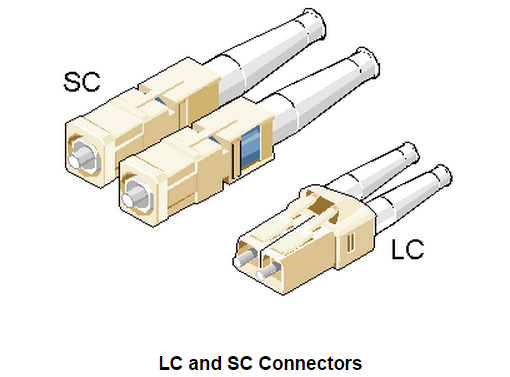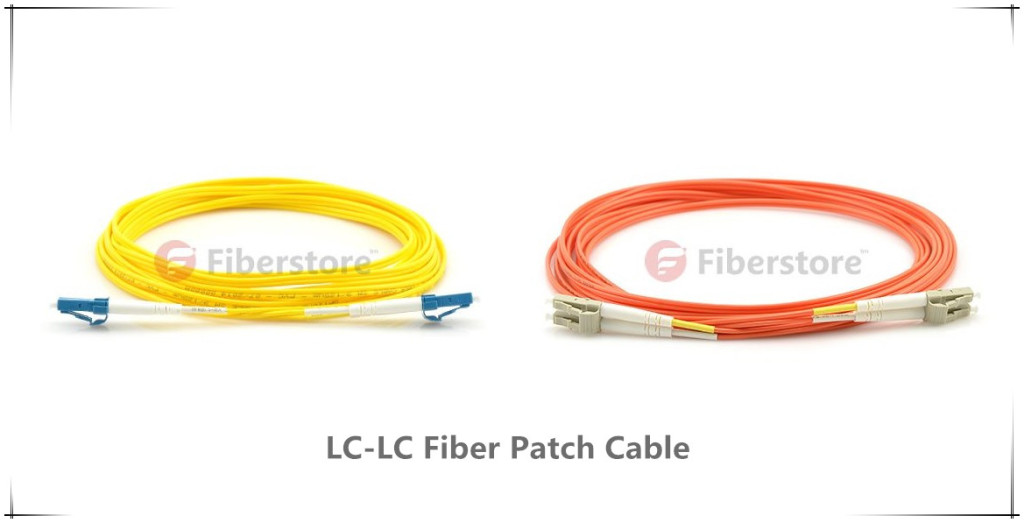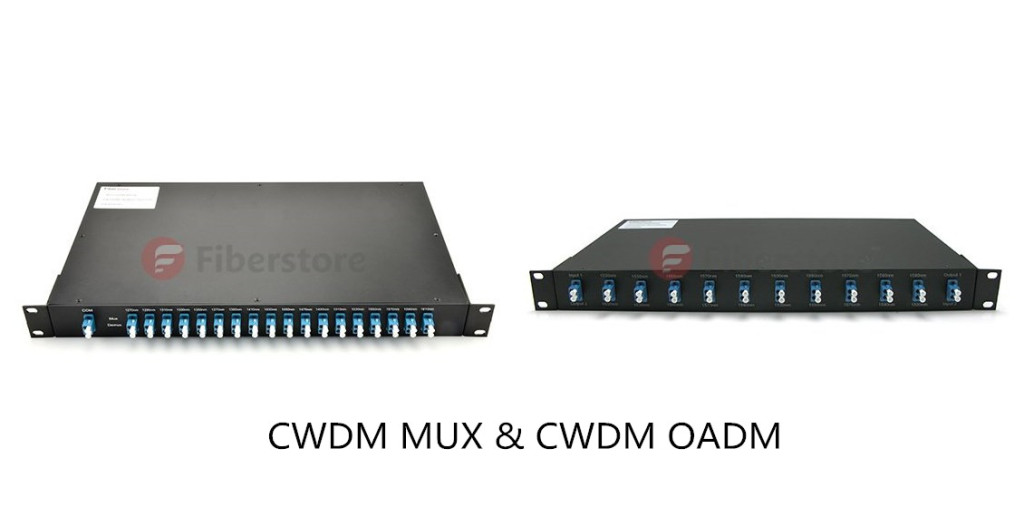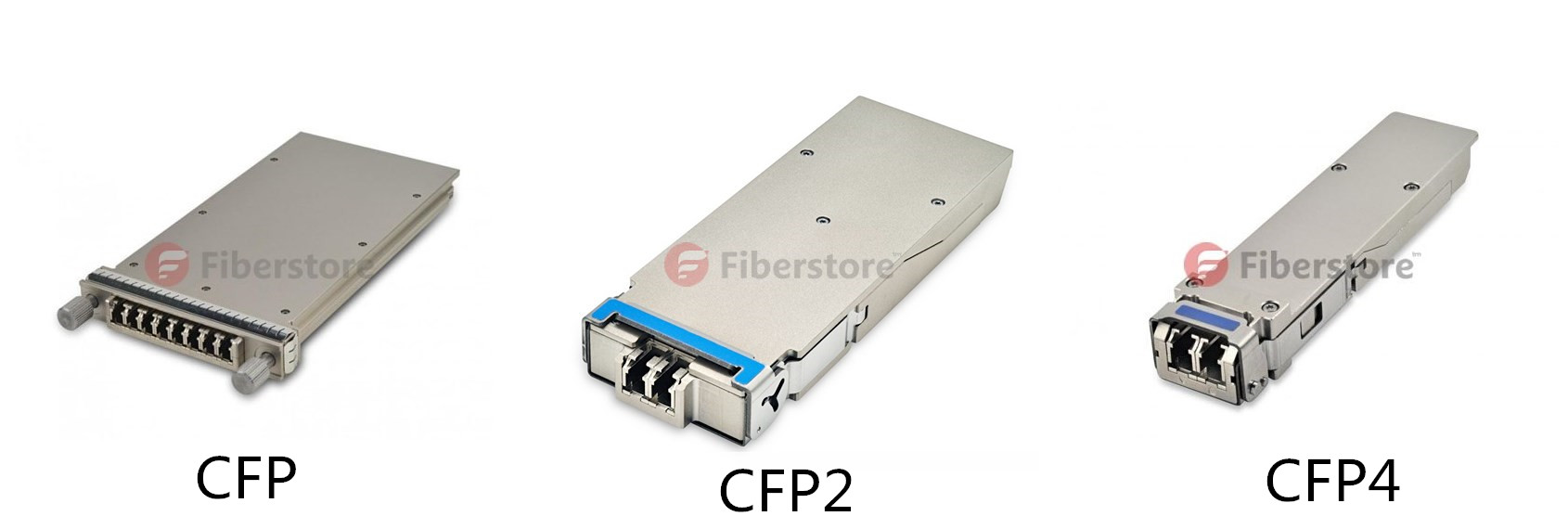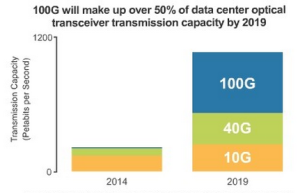-
In the past, because of low cost and compatibility with existing LANs, 100Mb/s Ethernet was very popular. As people’s increasing demands for faster delivery of information, high bandwidth Ethernet LAN is evolving. 1000BASE (1 Gbps Gigabit Ethernet) came around and brought Ethernet technology to a new stage. Gigabit Ethernet, as the new networking techology was a viable solution for increased bandwidth requirements. Early implementation of the technology will be in high-speed backbones and specialized workgroups. The initial standards of 1000BASE were created and maintained by the 802.3z working group of the IEEE LAN-MAN Standards Committee in June 1998.
Now that 1000Mb/s Ethernet has been applied generally, the corresponding equipment like the cable and transceiver are needed to make the network the most effective.
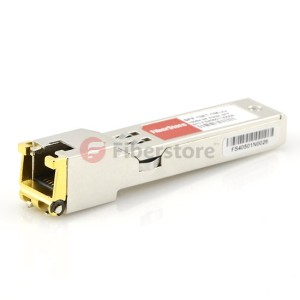
Before 2000, SFP optical transceiver module combines transmit and receive functions in a compact, low power, low cost package format. Now it’s widely applied in Fibre Channel, Gigabit Ethernet (GbE), and SONET/SDH and supports data rates between 125 Mb/s and 4 Gb/s. Later some manufacturers make SFP ports with copper transceivers. The copper small form factor pluggable (SFP) transceiver can maintain both configuration flexibility and high port utilization with low cost for optical networks. Due to these advantages, the need for copper SFP transceivers increases obviously.
Configuration Flexibility with High Port-level
When there is no copper transceiver, users who want to support Ethernet traffic over both copper and fiber should offer two different line cards dedicated to one media or the other or, alternatively, hybrid cards with a fixed number of copper ports and optical cages. But this way is not very efficient because the available ports for each type of media rarely matched the network's constantly evolving topologies.In today’s network environments, systems must deal with the ongoing convergence of data, voice, and video traffic as well as topologies that mix Internet Protocol (IP) with legacy PDH traffic and integrate specialized requirements such as Fibre Channel or ATM. As GbE switches, routers, and multi-service provisioning platforms (MSPPs), for example, must provide port-level flexibility for handling both fiber and copper interfaces, thus copper SFP transceiver becomes the best way to optimize port-level flexibility.
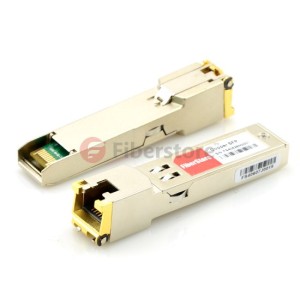
A Cisco copper SFP and an optical SFP provide exactly the same physical and electrical interface for any port on the line card. This just needs a single line card design that can handle the entire spectrum of copper and fiber connections. The port utilization copper SFP transceiver can more efficiently to accommodate the changing network requirements.
Low Cost
The traditional dedicated line card approach increases inventory costs because it has low level of field reconfiguration. Copper SFP transceiver and a common line card design for all ports clearly reduce the inventory costs as well as complete the copper to fiber reconfiguration.
All in all, copper SFP transceiver has the advantages such as increased port density, improved system utilization, and low overall costs. Copper SFP transceiver offers users a level of flexibility that did not exist before. So Copper SFP transceiver will still gain its popularity.
 votre commentaire
votre commentaire
-
Fiber optic patch cords are also known as fiber optic jumpers or fiber optic patch cables. Fiber optic patch cords are designed to provide optical connection for fiber networks within structured cabling systems. It’s a quick and easy method for routing fiber patches in data centers, head-ends, cellular hubs and central offices. It’s composed of two parts: optical connector and fiber optic cable. As to the connector, fiber patch cords could be terminated with LC/SC/ST/FC/MTRJ/MU/SMA connectors on both ends.
With the increasing deployment of fiber in the LAN, the need for small form factor fiber optic connectors is becoming urgent. The main reasons are deployment cost and space savings for cabling hardware and equipment interfaces. LC connector is a small form factor connector with half size of SC connector. The connector was invented by Lucent Technologies. Lucent is an American multinational telecommunications equipment company. So LC stands for Lucent Connectors. The connectors are made to support Telecom and Datacom networks.
The LC fiber patch cable is with a small form factor connector and suitable for high density applications. It’s compliant with IEC, Telcordia, EIA/TIA. One of the fiber optic patch cords LC series is LC to LC fiber patch cord. LC to LC fiber patch cord includes LC-LC single-mode and LC-LC multi-mode types.
LC-LC single-mode has two versions like simplex and duplex. Single-mode simplex fiber cable is single strand and single-mode duplex fiber cable is zipcord cable which is tight-buffered and jacketed. To be easily identified, the color of the cable jacket is often yellow. And the diameter is usually 1.8mm, 2mm or 3mm. The LC-LC single-mode fiber optic cables have the features of good performance and fast delivery. It’s used for long distance transmission.
LC-LC multi-mode patch cords are composed of a polymer outer body and inner assembly fitted with a precision alignment mechanism. As single-mode patch cords, this kind has both simplex and duplex versions too. These cables are with typical 50/125 and 62.5/125 optional multi-mode fiber. The cable diameter is 0.9mm, 2mm or 3mm. Due to the thick core size, the signal degradation caused by the refraction occurs. Thus it’s usually used for short distance signal transmission.
LC to LC fiber optic cables, as one kind of fiber optic patch cords, have many advantages such as high return loss, low insertion loss and back reflection loss, good durability, high temperature stability, good interchangeability and duplication. Thus they are widely used in Gigabit Ethernet and fiber channel, multimedia, telecommunication, and high speed data transmission throughout the network, etc.
 votre commentaire
votre commentaire
-
WDM (wavelength division multiplexing) technology transmitting multiple signals on a single optical fiber by using different wavelengths to carry each signal has been used since 1980s. In the middle of 1990s, dense wavelength division multiplexing (DWDM) enabled carriers to extend the capacity of the SONET/SDH rings in the network core, without installing new fiber. As the development of data service, MAN has become a hot topic of network construction. However, DWDM system brings telecom operators very high costs in MAN construction. So the other kind of WDM technology, CWDM (coarse wavelength division multiplexing) emerged.
CWDM has fewer channels than DWDM. The energy from the lasers in a CWDM system is spread out over a larger range of wavelengths than is the energy from the lasers in a DWDM system. CWDM has many advantages like low cost, low power consumption and small volume. As an economical and practical short-distance WDM transmission system, CWDM becomes more and more recognized by people in many MAN applications just as follows.
Fiber Exhaust Relief
Fiber exhaust which means lack of network capacity occurs in metropolitan networks. CWDM is a simple and cost-effective way for people to solve fiber exhaust. By using CDWM, new services can be added over an existing single optical fiber. So to increase optical network capacity, people don’t need to replace existing equipment with higher bit rate transmission rate and install new fibers. Otherwise, it will cost too much because installing new fiber is a costly venture in metropolitan areas.Low-cost WDM Deployments
CWDM system with reduced channels is beneficial for carriers in the metro-regional areas. It supports 4-channel configuration. Systems with 4 channels can quadruple the available capacity over an existing network segment, while offering a lower firstin deployment cost than an 8-channel system. For carriers, they should pay attention to two important points including cost and scalability when they need to upgrade to 8 channels systems. So CWDM is a good choice.Central Office to Customer Premise Interconnection
CWDM is a good fit for metro-access applications such as Fiber to the Building (FTTB). An 8-channel CWDM network can deliver 8 independent wavelength services from the Central Office to multiple business offices located in the same building.Due to the low cost, simplicity and scalability features of the latest products such as CWDM modules, CWDM systems is a good choice for overbuilding with Next Generation SONET, DWDM, and proprietary solutions. CWDM is becoming more and more popular among carriers who need to upgrade their networks to accommodate current of future needs while minimizing the use of valuable fiber strands especially in the metropolitan areas.
 votre commentaire
votre commentaire
-
Although 40 Gigabit Ethernet is fast enough to satisfy most of today’s common data transmission, more and more people are looking forward to 100 Gigabit Ethernet because of the increasing demands of higher speed and greater bandwidth. Hence the transmission from 40 Gigabit Ethernet to 100 Gigabit Ethernet will be similar to that from 10 Gigabit Ethernet to 40 Gigabit Ethernet when 100 Gigabit Ethernet becomes commercially available.
The migration from 40 Gigabit Ethernet to 100 Gigabit Ethernet requires special equipment like transceivers, cables, switches and connectors, etc. Transceiver is one of the important equipment because fiber connectivity in higher-speed active equipment is being condensed and simplified with plug-and-play, hot-swap transceiver miniaturization, so here just introduces transceivers. According to the latest report from Infonetics, 100G accounts for over half of all bandwidth deployed in carrier networks in 2014, and will grow rapidly through 2018. From below diagram you can see, 100G is similar to 10G in 2014, but in 2016, it exceeds 10G and grows rapidly in 2018.
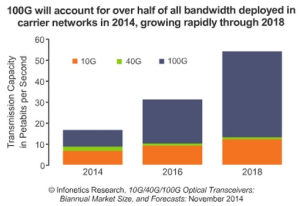
There are three kinds of transceivers. First, the C Form-Factor Pluggable (CFP) transceiver which contains 4 channels (each channel can support a data rate of 10 Gb/s) and brings a data rate up to 40 Gb/s. If the data rate should reach 100 Gb/s, CFP transceiver should feature 12 transmit and 12 receive 10-Gbps lanes. Second, CXP is usually called high-density CXP. CXP optical transceiver is hot pluggable. The CXP transceiver form factor provides 12 lanes in each direction for 100 Gigabit Ethernet. But it’s not wildly used for 40 Gigabit Ethernet. Third, the Quad Small-Form-Factor Pluggable (QSFP) is similar in size to the CXP and provides four transmit and four receive lanes to support 40 Gigabit Ethernet applications. If it’s used to serve 100 Gigabit Ethernet, the lane rates should increase to 25 Gbps.Compared to the components of 40 Gigabit Ethernet, components for 100 Gigabit Ethernet like 100G transceivers are still not so popular in the market due to the high costs. For example, the price of 40GBASE-SR4 QSFP+ transceiver may be about 500USD. But 100GBASE-LR4 CFP2 transceiver may be more than 6,000USD. So many manufacturers now put every effort to create a healthy 100G ecosystem, which will be beneficial for the entire community. Thus 100G solutions will soon meet customer’s power, performance, size and cost requirements. Once 100G components are commercial available, network operators will quickly capitalize 40G investments and adopt 100G transmission for their future deployments.
 votre commentaire
votre commentaire
-
In 2006, the IEEE 802.3 working group formed the Higher Speed Study Group (HSSG) and found that the Ethernet ecosystem needed something faster than 10 Gigabit Ethernet. Because the growth in bandwidth for network aggregation applications overpasses the capacities of networks employing link aggregation with 10 Gigabit Ethernet. HSSG is the first to propose that 100 gigabit per second for network aggregation applications. In January 2008, 100 Gb/s Task Force were formed. In June 2010, the 100GbE standards were approved. 100 Gigabit Ethernet (100GbE) means the computer networks transmitting data at rates of 100 gigabits per second.
There are two main advantages of 100 Gigabit Ethernet. And they are as following:
Fast speed: Compared with current 10 GbE protocol, 100 Gigabit Ethernet protocol is faster. The technology adheres to the principal Ethernet protocols and interfaces, while significantly boosting speeds and reducing network latency in the process. So for large users, 100 Gigabit Ethernet with heavy bandwidth and low latency is the best choice.Low cost: Carriers and enterprises have to use multiple 10 Gbps connections to satisfy their aggregated bandwidth requirements because there are no alternatives to 10 Gbps. Each new 10 Gbps bandwidth step comes with additional switch and/or computer interfaces which are expensive. For example, the costs for 10x10G fiber cabling are more than the 1x100G cost. In one word, multiple 10 Gigabit Ethernet channels cost more than 100 Gigabit Ethernet network with just one channel.
As 100 Gigabit Ethernet comes into our daily life, 100G transceivers have been specifically designed to meet the needs of high speed. What kind of transceivers is suitable? CFP (C form-factor pluggable) transceiver supports the ultra-high bandwidth requirements of data communications and telecommunication networks that form the backbone of the internet. It’s compatible to 100 Gigabit Ethernet. Now there are CFP optical transceiver, CFP2 optical transceiver and CFP4 optical transceiver. From the diagram, the transceivers are smaller and smaller but with more optimization.
Today people are moving to the cloud in order to keep information in case it will be lost from one’s local memory storage on a computing device. Thus it increases the bandwidth demand. Most IT leaders believe that this causes significant network overload. Though 10 Gigabit Ethernet and 40 Gigabit Ethernet are common now, it’s said that 100 Gigabit Ethernet will make up over 50% of data center optical transceiver transmission capacity by 2019. So 100 Gigabit Ethernet is considered to be an irresistible trend to multiplex and transmit high amounts of data.
 votre commentaire
votre commentaire
